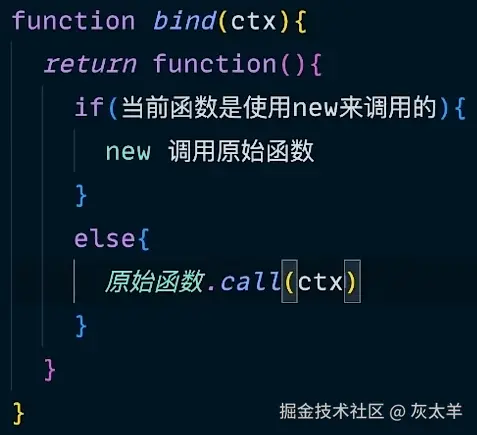this 是javascript中的一个关键字,并非是一个变量。
this 关键字指向的是一个对象,而指向哪个对象,或者是这个对象的值是什么取决于使用(调用)的方式和环境。
this 指向的值是可以通过手动方式去改变的,比如call 、 bind 、 apply方法。
this 在严格模式和非严格模式下也会有差别。
注意:谈this的指向是指在一个函数里面的this的指向,如果不在函数里面或在全局函数中,那就要看具体环境:
- 浏览器:
this指向window (严格模式下为undefined )
- node环境中:
this指向 {}
函数中的this指向谁完全取决于是如何 调用 这个函数的(只有在调用时才能确定this的指向)
绑定规则优先级: new绑定 > 显式绑定 > 隐式绑定 > 默认绑定
全局调用(默认绑定)
- 浏览器:
this指向window (严格模式下为undefined )
- node环境中:
this指向 {}
1
2
3
4
5
6
7
8
| let a = 0;
function testWindow() {
this.a = 1;
console.log(this.a);
console.log(window.a);
console.log(this);
}
testWindow();
|
1
2
3
4
5
6
7
| let a = 1;
function testStrict() {
"use strict";
console.log(this);
console.log(this.a);
}
testStrict();
|
隐式绑定
谁调用就指向谁。
当函数作为对象的方法调用时,this 通常指向该对象。
1
2
3
4
5
6
7
8
9
| const person = {
name: 'Alice',
greet() {
console.log('Hello, ' + this.name);
}
};
person.greet();
|
修改一下:
1
2
3
4
5
6
7
8
9
10
11
| let obj = {
name: 'obj',
foo: function () {
console.log(this);
function test() {
console.log(this);
}
test()
}
}
obj.foo()
|
1
2
3
4
5
6
7
8
9
| let obj = {
name: 'obj',
foo: function () {
console.log(this);
}
}
let bar = obj.foo
bar()
|
1
2
3
4
5
6
7
8
9
10
11
| function foo() {
console.log(this);
}
function bar(fn) {
fn()
}
let obj = {
name: 'obj',
foo: foo
}
bar(obj.foo)
|
函数作为参数时,参数函数叫做子函数,外面的函数叫父函数,子函数也叫回调函数,像这样的函数有很多,比如forEach 、setimeout,这些函数里的参数函数也叫内置参数
记住:父函数有能力决定子函数this的指向,例如forEach里第一个参数是一个函数,第二个参数就是this绑定的对象,不写默认绑定window
new绑定
不管是严格模式还是非严格模式,通过new 构造函数 , this都是指向构造函数创建的对象实例。
1
2
3
4
5
6
7
8
9
10
11
12
13
14
| function Test(a) {
this.a = a;
console.log(this.a);
}
Test.prototype.say = function () {
console.log(this);
console.log(this.a);
};
const t = new test(1);
console.log(t);
t.say();
|
显式绑定
在 JavaScript 中,显式绑定是通过 call() 、 apply() 或者 bind() 方法来手动指定函数执行时的 this 上下文。这种绑定方式允许我们明确地指定函数执行时想要使用的对象,而不依赖于函数的调用方式。
call
call() 方法允许我们调用一个函数并指定函数执行时的 this 上下文,传入函数的参数为零散接收即传入的参数用” , “ 隔开。
1
2
3
4
5
6
7
8
| function greet() {
console.log('Hello, ' + this.name);
}
const person = { name: 'John' };
greet.call(person);
|
apply
apply() 方法与 call() 类似,但是传入的参数为数组而不是一系列的零散参数。
1
2
3
4
5
6
7
8
9
| function greet(greeting) {
console.log(greeting + ', ' + this.name);
}
const person = { name: 'John' };
const args = ['Hello'];
greet.apply(person, args);
|
bind
bind() 方法创建并返回一个新函数,将原始函数绑定到指定的对象,并可选地预先设定部分参数。(参数匹配遵从就近原则)
bind的伪代码:

1
2
3
4
5
6
7
8
9
10
11
12
13
14
| function greet() {
console.log('Hello, ' + this.name);
}
const person = { name: 'John' };
const greetPerson = greet.bind(person);
greetPerson();
|
注意与new的优先级问题: new优先级更高:
1
2
3
4
5
6
7
8
| function func() {
console.log(this, this.__proto__ === func.prototype)
}
boundFunc = func.bind(1)
boundFunc()
|
1
2
3
4
5
6
7
8
9
| function func() {
console.log(this, this.__proto__ === func.prototype)
}
boundFunc = func.bind(1)
new boundFunc()
|
多次bind只认第一次的bind :
1
2
3
4
5
| function func() {
console.log(this)
}
func.bind(1).bind(2)()
|
箭头函数
箭头函数没有 this
箭头函数的this指向谁取决于该箭头函数定义的位置,而不是运行的位置 。因为它是基于闭包的,而闭包是基于词法作用域的。
技巧: 箭头函数的this看外层是否有函数
- 如果有,外层函数的
this就是内部箭头函数的this
- 如果没有,
this就是window
箭头函数的 this 是在创建它时外层 this 的指向。这里的重点有两个:
- 创建箭头函数时,就已经确定了它的
this 指向。
- 箭头函数内的
this 指向外层的 this。
1
2
3
4
5
6
| func = () => {
console.log(this)
}
func.bind(1)()
|
1
2
3
4
5
6
| func = () => {
console.log(this)
}
func.apply(1)
|
独立调用对箭头函数无效
1
2
3
4
5
6
7
8
9
10
| let a = 0
function foo() {
let test = () => {
console.log(this)
}
return test
}
let obj = { a: 1, foo: foo }
obj.foo()()
|
隐式绑定对箭头函数无效
1
2
3
4
5
6
7
8
| let a = 0
let obj1 = {
a: 1,
foo: () => {
console.log(this);
}
}
obj1.foo()
|
显式绑定对箭头函数无效
1
2
3
4
5
6
7
8
9
10
11
12
13
14
15
16
17
18
| let a = 0
function foo() {
let test = () => {
console.log(this)
}
return test
}
let obj1 = {
a: 1,
foo: foo
}
let obj2 = {
a: 2,
foo: foo
}
obj1.foo().call(obj2)
|
事件处理函数
在事件处理函数中,this指向被绑定的目标对象
1
2
3
4
5
6
7
8
9
10
11
12
13
14
15
16
17
18
19
20
21
| <body>
<button id="btn">click</button>
<button id="btn1">click1</button>
<script>
const btn = document.getElementById("btn");
btn.onclick = function () {
console.log(this);
this.innerHTML = "loading..";
this.disabled = true;
};
const btn1 = document.getElementById("btn1");
btn1.onclick = () => {
console.log(this);
};
</script>
</body>
|
内联函数
以下代码包含了严格模式和非严格模式不同的情况:
1
2
3
4
5
6
7
8
9
10
11
12
13
14
15
16
17
18
19
20
21
22
23
24
25
| <!DOCTYPE html>
<html lang="en">
<head>
<meta charset="UTF-8" />
<meta name="viewport" content="width=device-width, initial-scale=1.0" />
<title>Document</title>
</head>
<body>
<button onclick=" alert(this);">内联事件处理0</button> //元素本身即button
<button onclick="alert((function(){'use strict'; return this})());">内联事件处理1</button>
//undefined
<button onclick="alert((function(){ return this})());">内联事件处理2</button>
//window
<button onclick="'use strict'; alert(this.tagName.toLowerCase());">内联事件处理3</button>
//button
</body>
</html>
|













